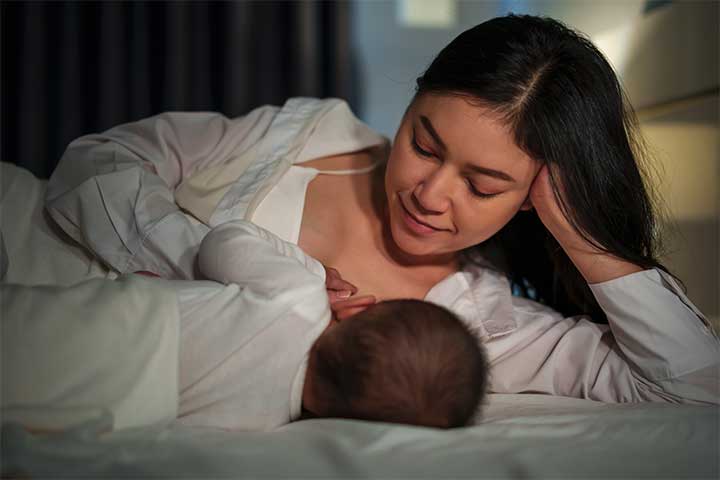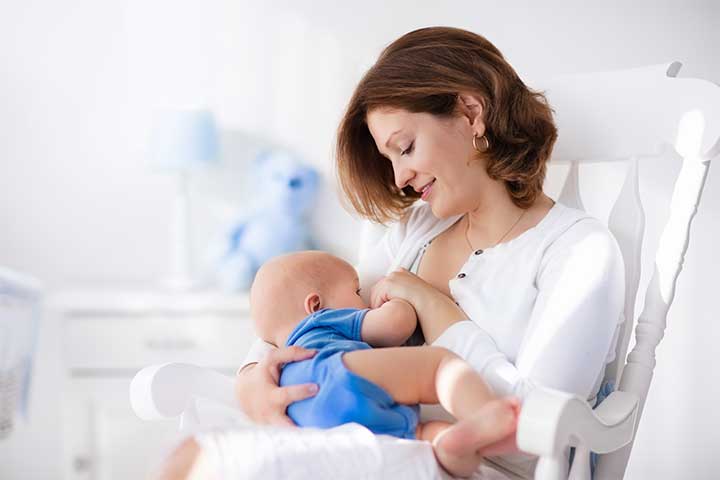
Image: Shutterstock
Breastfeeding is a unique journey that affects your body in unexpected ways. You may be curious about its connection to calorie burn and post-pregnancy weight. While breastfeeding can indeed influence your weight, it’s not a straightforward path. This article explores the relationship between breastfeeding, calories, and post-pregnancy weight loss, highlighting the roles of nutrition, exercise, individual variations, and hormonal changes. Read on to know more!
How Many Calories Are Burnt While Breastfeeding?
Image: Shutterstock
The calorie-burning magic of breastfeeding is indeed fascinating, and the numbers may surprise you. On average, breastfeeding can torch anywhere from 300 to 500 extra calories per day (1). To put it into perspective, that’s akin to the calories burned during a moderate 30-minute workout. However, please keep in mind that these figures are approximate and can fluctuate depending on various factors. For some mothers, the number may be higher, while for others, it might be slightly lower.
The actual calorie-burning power of breastfeeding is influenced by a blend of factors. Your Basal Metabolic Rate (BMR), frequency and duration of feeding, milk production, and your body composition all play essential roles. As your body works harder to produce breast milk, your BMR may increase, leading to higher calorie consumption (2). Also, the more often and the longer you breastfeed, the more calories you’re likely to burn. The energy required for milk production and your unique body composition further determines the calories you burn.
Effect On Post-Pregnancy Weight Loss
Image: Shutterstock
Breastfeeding’s impact on post-pregnancy weight loss is significant but not guaranteed. The outcome depends on various factors. Healthy eating is vital; while breastfeeding can create a calorie deficit, a balanced diet is essential for proper nutrition and weight loss.
Exercise plays a pivotal role, but don’t rush into intense workouts post-childbirth. Consult your healthcare provider for safe exercise timing.
Individual variation is substantial. The rate of post-pregnancy weight loss varies among individuals, emphasizing a gradual, healthy approach.
Hormonal changes affect appetite and metabolism. Some mothers experience increased hunger, while others find breastfeeding naturally curbs their appetite. Striking a balance between calorie intake for breastfeeding and creating a manageable deficit is key.
Nutritional Tips For Breastfeeding Moms
Image: Shutterstock
Maintaining a healthy diet while breastfeeding is essential for both you and your baby. The following nutritional tips can help you make informed choices:
1. Stay Hydrated
Adequate hydration is crucial. Breastfeeding increases your fluid needs, so make sure to drink plenty of water to stay well-hydrated.
2. Select Foods Rich In Nutrients
Choose nutrient-dense foods like fruits, vegetables, whole grains, lean proteins, and healthy fats. These choices provide the essential vitamins and minerals needed for both you and your baby’s health.
3. Avoid Empty Calories
Limit your consumption of sugary, high-calorie, and low-nutrient foods. These items can provide empty calories and may not support your overall health and energy levels.
4. Consider Caloric Intake
It’s essential to meet your calorie needs, but not to over consume. A general guideline is to add about 300 to 500 calories to your daily intake while breastfeeding (3). This should be sufficient to support your milk production and maintain your energy levels.
5. Take A Prenatal Vitamin
Continue taking a prenatal vitamin to ensure you’re receiving all the necessary nutrients. Your healthcare provider can recommend a suitable option for you.
6. Consult A Healthcare Provider
While breastfeeding can create a calorie deficit and potentially support post-pregnancy weight loss, the actual impact on your body can vary greatly. The best course of action is to consult your healthcare provider for personalized guidance and recommendations based on your specific circumstances.
Balancing Self-Care With Breastfeeding
Image: Shutterstock
Juggling breastfeeding and self-care is vital for managing calorie burn and post-pregnancy weight loss. Here’s how to achieve that balance effectively:
1. Prioritize Rest
Adequate rest is essential for your energy levels and calorie management. Lack of sleep can lead to increased appetite and cravings. Take short naps when possible and ensure you get enough nighttime sleep.
2. Manage Stress
Reducing stress is key to maintaining a healthy diet. High stress levels can lead to emotional eating and unhealthy choices. Find stress-relief techniques that work for you, like mindfulness, gentle exercise, or seeking support from loved ones.
3. Exercise Smart
Incorporate postpartum-friendly exercise into your routine. Consult your healthcare provider for guidance on safe exercises. Even short walks or light yoga sessions can help manage your calorie burn and improve your mood.
4. Make Time For Yourself
Allocate a few minutes each day for “me time.” Engage in activities you enjoy, whether it’s reading, taking a bath, or pursuing a hobby. A happy and relaxed mother is better equipped to care for her baby and herself.
Breastfeeding is a beautiful and rewarding experience, not just for your baby but also for your overall health. It can indeed contribute to calorie burn and post-pregnancy weight loss, but the exact number of calories burned varies among individuals. Your focus should remain on maintaining a balanced diet, staying well-hydrated, and listening to your body’s needs. Nourishing both you and your baby with love and care is the primary goal. In doing so, you’ll not only support your baby’s growth and development but also ensure your well-being during this remarkable chapter in your life.
















